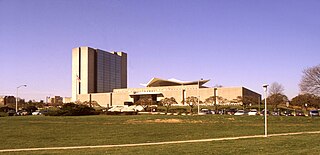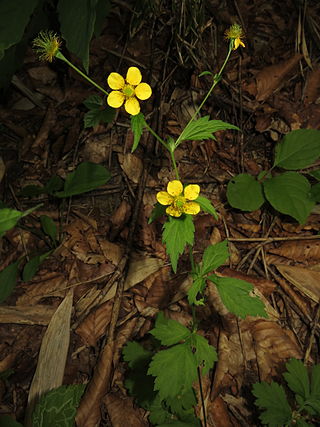
Dichlorodiphenyltrichloroethane, commonly known as DDT, is a colorless, tasteless, and almost odorless crystalline chemical compound, an organochloride. Originally developed as an insecticide, it became infamous for its environmental impacts. DDT was first synthesized in 1874 by the Austrian chemist Othmar Zeidler. DDT's insecticidal action was discovered by the Swiss chemist Paul Hermann Müller in 1939. DDT was used in the second half of World War II to limit the spread of the insect-borne diseases malaria and typhus among civilians and troops. Müller was awarded the Nobel Prize in Physiology or Medicine in 1948 "for his discovery of the high efficiency of DDT as a contact poison against several arthropods". The WHO's anti-malaria campaign of the 1950s and 1960s relied heavily on DDT and the results were promising, though there was a resurgence in developing countries afterwards.

A CAS Registry Number is a unique identification number assigned by the Chemical Abstracts Service (CAS) in the US to every chemical substance described in the open scientific literature. It includes all substances described since 1957, plus some substances from as far back as the early 1800s. It is a chemical database that includes organic and inorganic compounds, minerals, isotopes, alloys, mixtures, and nonstructurable materials. CAS RNs are generally serial numbers, so they do not contain any information about the structures themselves the way SMILES and InChI strings do.

Toxicity is the degree to which a chemical substance or a particular mixture of substances can damage an organism. Toxicity can refer to the effect on a whole organism, such as an animal, bacterium, or plant, as well as the effect on a substructure of the organism, such as a cell (cytotoxicity) or an organ such as the liver (hepatotoxicity). By extension, the word may be metaphorically used to describe toxic effects on larger and more complex groups, such as the family unit or society at large. Sometimes the word is more or less synonymous with poisoning in everyday usage.

Trichloroethylene (TCE) is a halocarbon with the formula C2HCl3, commonly used as an industrial degreasing solvent. It is a clear, colourless non-flammable liquid with a chloroform-like pleasant and pungent smell. The IUPAC name is trichloroethene. Industrial abbreviations include TCE, trichlor, Trike, Tricky and tri. It should not be confused with the similar 1,1,1-trichloroethane, which is commonly known as chlorothene.

Ethyl carbamate (also called urethane) is an organic compound with the formula CH3CH2OC(O)NH2. It is an ester of carbamic acid and a white solid. Despite its name, it is not a component of polyurethanes. Because it is a carcinogen, it is rarely used, but naturally forms in low quantities in many types of fermented foods and drinks.

The pyrethrins are a class of organic compounds normally derived from Chrysanthemum cinerariifolium that have potent insecticidal activity by targeting the nervous systems of insects. Pyrethrin naturally occurs in chrysanthemum flowers and is often considered an organic insecticide when it is not combined with piperonyl butoxide or other synthetic adjuvants. Their insecticidal and insect-repellent properties have been known and used for thousands of years.

The United States National Library of Medicine (NLM), operated by the United States federal government, is the world's largest medical library.
Environmental Defense Fund or EDF is a United States-based nonprofit environmental advocacy group. The group is known for its work on issues including global warming, ecosystem restoration, oceans, and human health, and advocates using sound science, economics and law to find environmental solutions that work. It is nonpartisan, and its work often advocates market-based solutions to environmental problems.

Mitotane, sold under the brand name Lysodren, is a steroidogenesis inhibitor and cytostatic antineoplastic medication which is used in the treatment of adrenocortical carcinoma and Cushing's syndrome. It is a derivative of the early insecticide DDT and an isomer of p,p'-DDDTooltip dichlorodiphenyldichloroethane (4,4'-dichlorodiphenyldichloroethane) and is also known as 2,4'-(dichlorodiphenyl)-2,2-dichloroethane (o,p'-DDD).
Exogenous bacteria are microorganisms introduced to closed biological systems from the external world. They exist in aquatic and terrestrial environments, as well as the atmosphere. Microorganisms in the external environment have existed on Earth for 3.5 billion years. Exogenous bacteria can be either benign or pathogenic. Pathogenic exogenous bacteria can enter a closed biological system and cause disease such as Cholera, which is induced by a waterborne microbe that infects the human intestine. Exogenous bacteria can be introduced into a closed ecosystem as well, and have mutualistic benefits for both the microbe and the host. A prominent example of this concept is bacterial flora, which consists of exogenous bacteria ingested and endogenously colonized during the early stages of life. Bacteria that are part of normal internal ecosystems, also known as bacterial flora, are called Endogenous Bacteria. A significant amount of prominent diseases are induced by exogenous bacteria such as gonorrhea, meningitis, tetanus, and syphilis. Pathogenic exogenous bacteria can enter a host via cutaneous transmission, inhalation, and consumption.

Bisoctrizole is a phenolic benzotriazole that is added to sunscreens to absorb UV rays. It is a broad-spectrum ultraviolet radiation absorber, absorbing UVB as well as UVA rays. It also reflects and scatters UV.
Sodium salicylate is a sodium salt of salicylic acid. It can be prepared from sodium phenolate and carbon dioxide under higher temperature and pressure. Historically, it has been synthesized by refluxing methyl salicylate with an excess of sodium hydroxide.
TOXMAP was a geographic information system (GIS) from the United States National Library of Medicine (NLM) that was deprecated on December 16, 2019. The application used maps of the United States to help users explore data from the United States Environmental Protection Agency's (EPA) Toxics Release Inventory (TRI) and Superfund programs with visual projections and maps.

Protein BANP is a protein that can be found in humans, it is encoded by the BANP gene. It is a member of the human gene family, "BEN-domain containing", which includes eight other genes: BEND2, BEND3, BEND4, BEND5, BEND6, BEND7, NACC1 (BEND8), and NACC2 (BEND9). BANP is a protein coding gene that is located in the Nucleoplasm. Its official name is BTG3 associated with nuclear protein. It plays a role in DNA binding, chromatin regulation, repressor, transcription regulation and the cell cycle process. In recombination BANP protein represses T-cell receptors to control recombination during transcription. As a tumor suppressor BANP negatively regulates p53 transcription in recombination. It can be expressed in various tissues in the body including the testis, spleen, and the placenta.

Geum japonicum, known as Asian herb bennet, is a yellow-flowering perennial plant native to North America and East Asia, especially Japan. It may be synonymous with Geum macrophyllum, the North American flower. As a traditional herbal remedy it is known as an astringent and used in poultices. However, in recent years, the Thunberg variant has received attention for other possible medical uses.
To protect the environment from the adverse effects of pollution, many nations worldwide have enacted legislation to regulate various types of pollution as well as to mitigate the adverse effects of pollution. At the local level, regulation usually is supervised by environmental agencies or the broader public health system. Different jurisdictions often have different levels regulation and policy choices about pollution. Historically, polluters will lobby governments in less economically developed areas or countries to maintain lax regulation in order to protect industrialisation at the cost of human and environmental health.
Velsicol Chemical Corporation is an American chemical company based in Rosemont, Illinois, that specializes in chemical intermediates for applications such as agrochemicals. It was founded in 1931 by Joseph Regenstein and Julius Hyman.
Persistent, bioaccumulative and toxic substances (PBTs) are a class of compounds that have high resistance to degradation from abiotic and biotic factors, high mobility in the environment and high toxicity. Because of these factors PBTs have been observed to have a high order of bioaccumulation and biomagnification, very long retention times in various media, and widespread distribution across the globe. Most PBTs in the environment are either created through industry or are unintentional byproducts.
Clinicogenomics, also referred to as clinical genomics, is the study of clinical outcomes with genomic data. Genomic factors have a causal effect on clinical data. Clinicogenomics uses the entire genome of a patient in order to diagnose diseases or adjust medications exclusively for that patient. Whole genome testing can detect more mutations and structural anomalies than targeted gene testing. Furthermore, targeted gene testing can only test for the diseases for which the doctor screens, whereas testing the whole genome screens for all diseases with known markers at once.

Diglycidyl resorcinol ether, also called Resorcinol diglycidyl ether (RDGE) is a liquid aromatic organic chemical compound and chemically a glycidyl ether.















